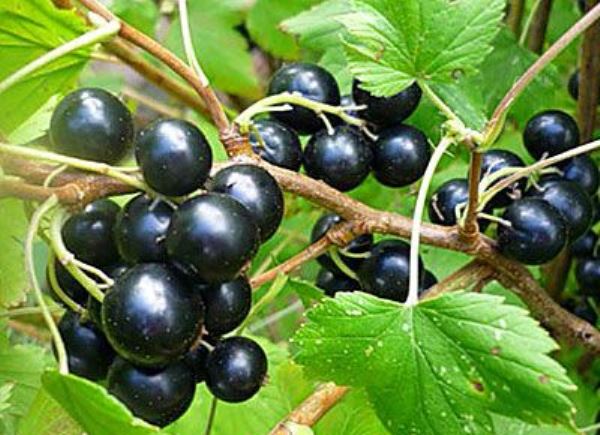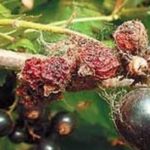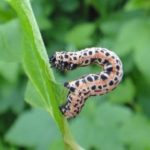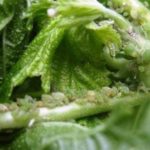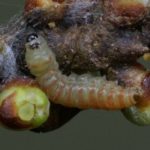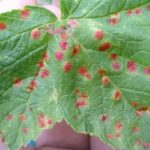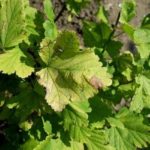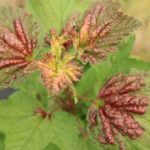One of the favorite berries in gardeners is currants. Variety Yadrenaya pleases large black fruits with beneficial propertiesas well as its abundant harvest every year. A detailed description of this variety can be found below.
Table of contents
History of currant removal Vigorous
Grade Yadrenaya was obtained as a result of crossing varieties Dikovinka with Bredthorp and Favorite Altai. L.N. M.A. Lisavenko. In 2000, the variety was entered into the State Register of Varieties, and allowed for use in the Volga-Vyatka and West Siberian regions.
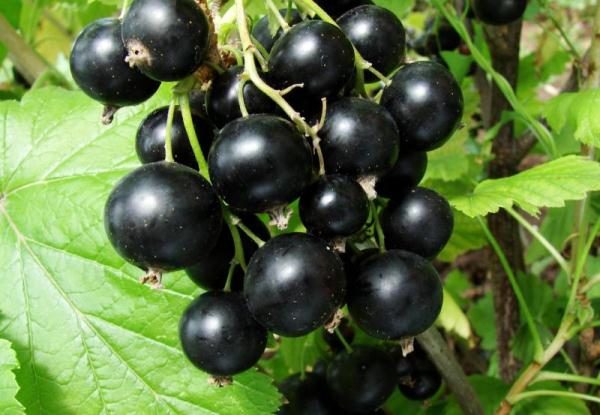
However, the variety got its distribution in many other regions of Russia. Successfully grows in the Volga region, in the Central region, at mid-latitudes and in the Far East.
Description of the variety and berries
Variety Yadrenaya refers to black varieties of currants. By itself, the bush srednerosly, height from 1.5 m. The branches are rather sprawling, of medium thickness with a light brown crown. Growing young shoots can be immediately distinguished from old branches due to the light green color of the crown. The buds on the currant are egg-shaped, of a light red tone, are formed on a node of 2-5 pieces.
The bush blooms in the middle of spring, the flowers are small, with white and pink petals, emit a pleasant sweet aroma. Formed on a long stalk from 4 to 10 pieces. The stem is strong, dark brown in color. Although the variety belongs to self-pollinating, it is good to plant it near other varieties of currants. The leaves of the bush consists of 5 blades, while the central part is longer than the others. A leaf of dark green color, young foliage of light green tones, closer to autumn they acquire red-brown shades.. Along the edges of the leaf plate are small notches.
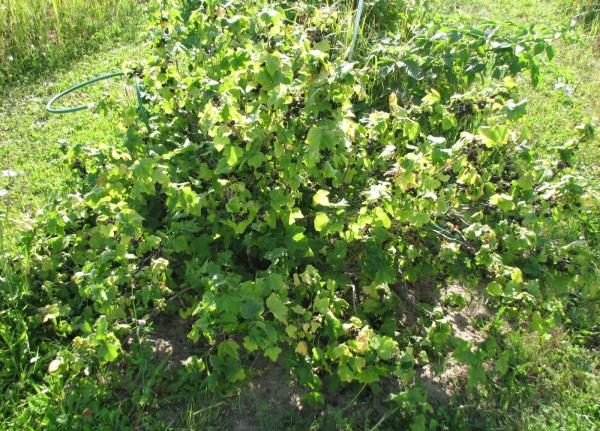
The berries are large, this type of currant is the record for the largest fruits. On one stalk there are up to 10 berries, of different sizes.. The largest berry can be compared with a 5-ruble coin, and its weight reaches up to 8-10 grams. Fruits are vigorous black, round shape. Berry with a rather thick peel and small yellow-brown seeds inside. The flesh is dense, juicy, the currant has a sweet-sour rich taste and a pleasant aroma. The ripening of berries begins in June and by the middle of summer the berries are fully ready for harvest.
Merits
Undoubtedly, the currant varieties "vigorous" has many advantages:
- Among them is a great low temperature tolerance, the variety is winter-hardy and survives well even the most severe winters;
- The shrub brings the first berries already in the 2nd year after planting, besides annually happy rich harvest, over 6 kg of berries are harvested from an adult bush;
- The undoubted advantage of the variety is fruit size;
- In addition to this variety Yadrenaya endures many diseases, for example, powdery mildew, not scary shrubs and pests.
disadvantages
- Among the disadvantages of the variety is a little sour taste currants;
- Besides plucked fruits are not able to be stored for a long time, the berry should be immediately processed, saved no more than 3 days in a torn form;
- Poses long transport, fruits produce juice and lose their presentation;
- Besides the bush grows old over time, branches dry quickly and do not bear fruit;
- Just currant is very capricious, her need constant care and comfortable growth conditionsotherwise the berries become smaller and more sour.
Breeding methods
Layering
For reproduction of currants using this method, only annual shoots are suitable. It is possible to propagate currants in this way in early spring, the main thing is to prepare the soil well, add organic fertilizers to it, which perfectly retain moisture in the ground, which contributes to the rapid formation of roots. A shallow furrow is made in the soil near the mother bush.In the selected shoot, with a sharp knife, a small armhole is made, it is from here that the roots will be formed. Now the branch is pinned to the ground with the help of a metal bracket, or it is simply pressed tightly by the ground from above. However, the layer of earth should not be more than 3-4 cm. The top of the branch should remain on the soil surface.
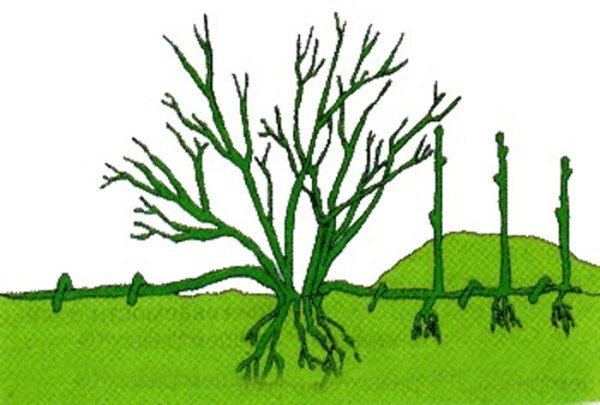
Caring for a currant is simple, the main thing is always to maintain the moisture of the soil, otherwise the roots will form slowly and grow longer. Besides the land around you need to constantly spud, as if sprinkling on top, it contributes to the formation of adventitious roots in the bush. Within a couple of weeks, young buds and leaves will start to form on the branch, which means that the cutting has formed roots and after it has gotten a little stronger, it can be safely separated from the mother bush.
It is necessary to divide a branch in the fallwhen the heat slept, but still far from the first frost. The earth around the branch is carefully dug out and with the help of a spade the stalk is separated from the main bush. Now the seedling is able to grow independently or it can be safely transplanted to a new place.
Cuttings
It is necessary to prepare cuttings in late autumn.. To do this, using a sharp pruner, a cutting is cut from a branch from 15 to 18 cm, it should have at least 3-4 buds. It is recommended to make cuts not straight, but at an angle of 45 degrees. Keep the branches strictly vertically, in a cool, but dry place (refrigerator). You can prikopat cuttings in the snow next to the mother bush, but at the same time impose them with sawdust or straw.
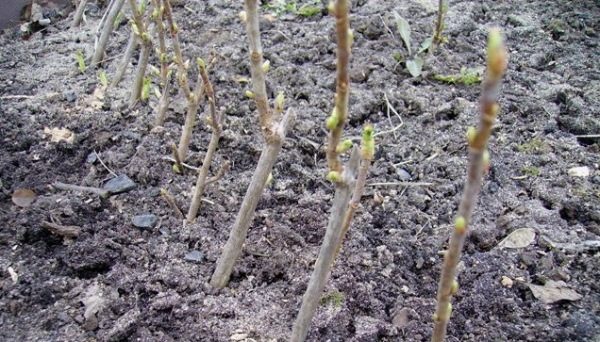
After the earth has warmed up, the cuttings can be immediately planted into the soil, simply placing them in the heated soil a little at an angle, sprinkle with an earthy mixture and pour on a little. Wherein It is important to observe the distance between seedlings, not less 15-20 cm. But if it is not possible to plant in the ground right away, you can put currant cuttings in a pot or a regular cut bottle. In spring, the seedlings are transplanted to a permanent place of growth, and by the autumn the bush will get stronger, which means that with the right care, next year you can get a harvest.
Dividing bush
Perhaps the easiest and most effective way to reproduce currants. And it comes down to the fact that the adult currant bush digging around, carefully removed from the ground. The root system is examined for the presence of disease., dry parts of the root system are cut off, and the shrub is placed in a solution of potassium permanganate to prevent diseases. Further, the shrub with an ax or shovel is divided into several parts, but it is important that roots remain on each part, otherwise the currant will simply die.
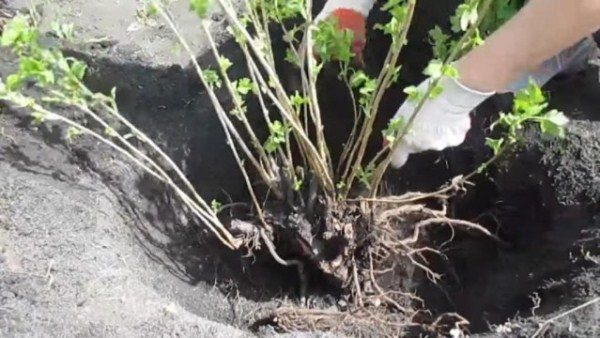
Next, the hotel parts are placed in the landing pits, powdered with earth. In the future, seedlings need watering and care. It is possible to carry out such transplantation both in the autumn, and in the spring. At the same time already on the 2nd year of planting currants will give the first harvest.
Planting currants
Selection of seedlings
Currant Yadrenaya perfectly survives in new places, but in order for the young seedling to get stronger, it is better to choose a 2-year-old bush with 2-3 strong shoots. Wherein the leaves and the twigs themselves should not be lethargic and damaged. The presence of brown spots on the leaves indicates the presence of fungal diseases, as there should be no white bloom and other signs of the disease.
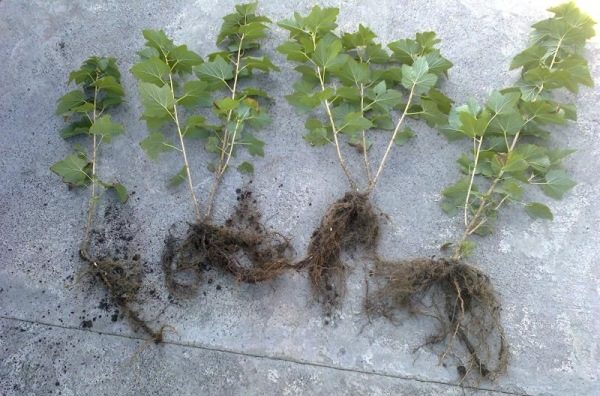
Branches and leaves should have a light brown and green saturated colors. The root system should have 2-3 separate shoots, no longer than 25-30 cm.The roots have a dark brown color, it is also worth examining them for the presence of diseases and pests. Many seedlings are sold in pots, it can be easily removed from the container. If the earth is well showered from the roots - currants are healthy and ready for transplant. Also, the ground in the pot should be moist and lump free.
Choice of place and time
Currants can be planted both in spring and in autumn. In spring, early May is considered the best time to land.when the frosts were gone, and the earth warmed a little by the sun. In spring, when planting, it is important to water the young seedling well. In the fall, you can start planting in mid-September., but here it is important to have time to plant before the onset of the first frosts, so that the currants have time to settle down in a new place.
When choosing a place for planting a bush should be based on the fact that over time the shrub will grow greatly in width and height. Pick up well-lit places with lots of sunshine throughout the day.
Soil preparation
Preparing a place for landing is necessary for 2 weeks. A small hole is dug out, 50x80 cm is enough, and there is enough depth for a spade bayonet. From the soil are selected all the weeds of other plants, stones, stones, the ground in the pit should remain loose and soft. Now it is necessary to pour a few buckets of water into it, it is necessary that the earth settles.
Landing technique
Before planting, carefully examine the seedling, remove dry parts from roots.
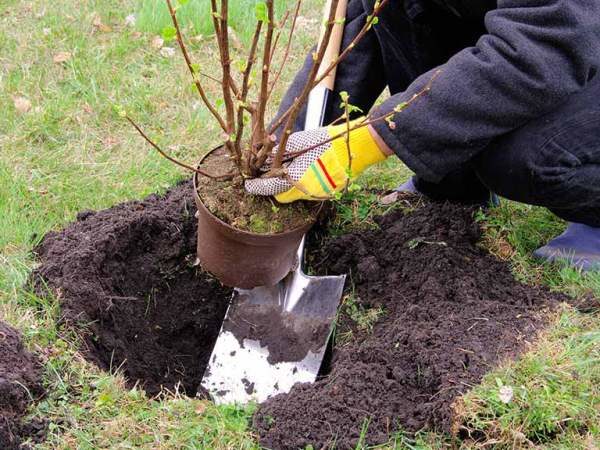
Further, top dressing should be placed on the bottom of the pit, peat, humus, dry leaves or sawdust with ash should be used; this mixture should be mixed with the soil. In the pit sapling falls plant deeply is not worth it, just lightly cover the roots with soft soil and slightly crush. After that, be sure to pour the currants with warm water.
Further watering currants requires 2-3 days, 1-2 buckets water depending on weather conditions. After a couple of weeks, swollen buds will become noticeable on the branches, then the leaves will begin to bloom, and this is a good sign that the currant has taken root in a new place.
Care
Watering and loosening
To currants gave every year a large crop, the bush requires a moist soil. In general, for the whole summer season the currant needs careful watering around 4 times. In early spring, before the flowering, the roots need moisture. The second time the currant needs watering during fruit ripening. Another careful watering is to be done after harvesting and, finally, the last time the shrub needs to be harvested well in late September. Throughout the summer, especially in hot weather, the bush can be watered as the land dries.
Loosening should be done a couple of days after watering.. Loosening provides the roots with additional oxygen, also removes weeds and helps get rid of many soil pests.
Top dressing
Fertilizing of currant begins to be carried out from the 2nd year after planting, if during planting fertilizers were introduced into the planting pit. Better to feed at least 2 times a year. In the spring it is good to feed currants with urea, manure or peat. The currant also favorably responds to sawdust and ash. During the summer, a solution of a cowshed, mineral, potash or phosphate fertilizers must be applied under the young bush; this will increase the size of the berries.
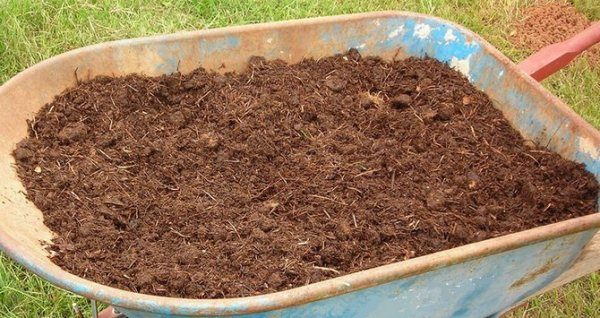
In the autumn under the bush you can make half a bucket of humus. It is worth noting that you can not pour fertilizer just on the ground. To do this, around the shrub need to dig a small trench, fertilizer and dig with the ground.
Pruning
Currant pruning is done in the spring before bud break and in autumn. In the first year pruning is not carried out, because seedlings are still too small. On 2nd year currant bush already formed 3-5 main strong shoots, the other young branches are cut. The remaining branches shorten the tops of 2-3 buds.

At first glance, cutting a young bush so badly is dangerous, because the plant can get very sick and die. But this is not the case; pruning will allow the shrub not to waste forces on the shoots that do not yield crops, besides pruning allows you to increase the berries in sizeand increase the amount of the crop. On 3-4 year 5-6 strong shoots are left. The branches that were formed last year are shortened to 3-4 buds, the rest is cut. On 5-6 year pruning follows the same pattern. In the autumn it is necessary to carry out sanitary pruning., namely to cut the branches that are broken, damaged by diseases and pests, as well as shading fruit-bearing branches.
Preparing for the winter
Grade Currant Yadrenaya refers to frost-resistant varieties, tolerate low temperatures well and are not afraid of frost. In the fall, the trunk circle needs to be lined up.This will destroy all insects that love to winter in the roots of the plant.
Also, the currant trunk can be lined with lapnik or lay covering material, but mostly only young seedlings need such shelter, adult bushes hibernate well and without shelter.But the currant branches must be tied up with ropes, moving in a spiral - this will save them from breakage during strong winds.
Diseases and pests
The variety withstands many diseases and pests. But especially likes succulent leaves of currants gooseberry drop. This insect simply eats all the leaves on the bush, not touching only the petiole.
Gooseberry firing pin leaves on the currant white cobwebs on clusters of berries, which subsequently do not ripen.
Kidney mole - the insect attacks the shrub in early spring, the buds and berries dry and fall, and the shoots become brown-brown, and then dry.
And, of course, she especially likes currants. aphid. A small green pest sucks the juice from the leaves and buds, the leaves curl, dry and fall. Aphid is able to destroy all currants in the summer cottage in the summer.
- Gooseberry firing pin
- Gooseberry moth
- Shoot Aphid
- Kidney mole
But currant suffers not only from pests. Anthracnose forms on bushes in early summer, currant leaves are covered with small brown spots that grow and cover the entire leaf.After that, the leaves curl and fall off, if no action is taken at the time, the shrub dies in 3 years.
White spot appears mainly on the outside of the leaf plate as black dots. Over time, they become a dark brown tone, and the sheet dries and falls. On young shoots and berries also appear brown spots.
Glass rust begins to occur in late May - early June in the form of blistering on the leaves of orange color. The disease can not only destroy the crop, it extends to the leaves and shoots of currants.
- Currant anthracnose
- White currant spot
- Currant rind
Prevention
So that neither diseases, nor pests could destroy the harvest, currants should be sprayed in early spring, before flowering. You can handle a 3% solution of Bordeaux mixture, Karbofos or Spark. It is also good to use in the fight against diseases and pests folk remedies, for example, a solution of ash and laundry soap, an infusion of dandelions and garlic, an infusion of yarrow. In addition to spraying, it is important to monitor the condition of the soil, promptly remove infected branches and leaves,to cut and provide currants good conditions for growth, only then the shrub will delight rich harvest.
Currant varieties Yadrenaya - a great view, which gives large fruits, sweet and sour to taste, they are not only good fresh, but also in the blanks. Although the variety is capricious in care, it requires the attention of a gardener, but a rich harvest more than pays back all efforts.
